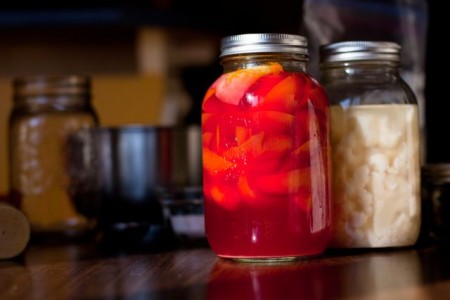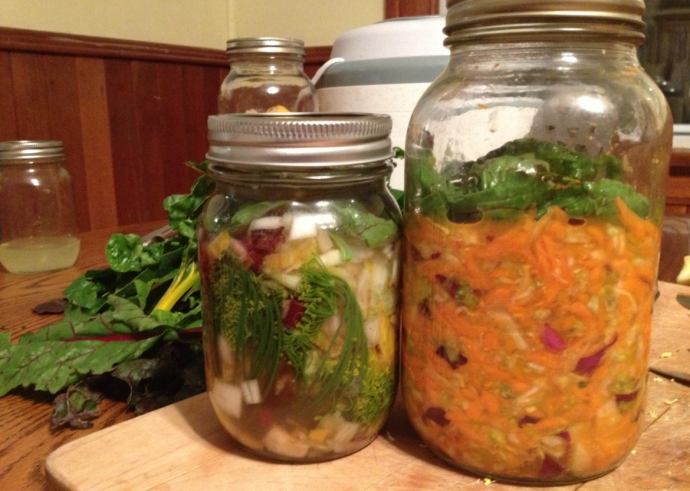Have you ever wondered what the difference is between canning food and culturing, or fermenting it?
There are many differences that you might want to consider…and you’ll learn more about what’s right for your family over time.
As a homesteader, I have a diversified food preservation strategy and I both can and ferment.
So let’s start with canning.
There are many benefits to canning- including that you get to preserve the harvest and stretch some of that local, sustainable yumminess throughout the winter. No one, and I mean no one, complains when you open some applesauce, canned garden tomatoes or zucchini relish in February.
But the process of canning itself requires special knowledge, skills, and equipment. It’s a bit cumbersome and tedious. Particularly if you are standing over that hot water bath sterilizing and sealing jars in an August heatwave.
The process itself requires immersing your filled jars in a ‘hot water bath’ for a set amount of time. This process seals the jar and it kills any the high temperatures kill any micro-organisms that are present and might cause spoilage. That is a double-edge sword though, as many of those micro-organisms boost our health and digestion. So rendering your food ‘dead’ isn’t necessarily optimal.
Culturing, or fermenting, on the other hand, requires no special tools (unless you think of a jar as a special tool). Your equipment needs to be clean, not sterile. And it takes minutes to make. The outcome is a food that is at once tasty, medicinal, and healing.
It’s the traditional food skill that people adore learning and I adore teaching in my classes and traditional foods teacher training.
It’s only drawback (in my mind) could be that it requires cold storage. Of course that wasn’t an issue when households all had a cold cellar to overwinter their garden harvest and preserves. Today, the fridge has taken its place and one can find their space a bit limited. But a cold floor in the basement can also do the trick in a pinch.

Lacto-fermentation has been used by people around the world to preserve food long before freezers, pressure cookers and canners ever made their way into our lives…
Sugars and starches are converted into lactic acid. This is the work of lactobacilli present on the outside of most foods- particularly those on, or near the ground. Lactobacilli inhibits putrefying bacteria, thereby acting as a natural preservative.

In fact, under the right conditions, fermentation will occur naturally in many foods. Humans learned to harness this natural preservation method thousands of years ago.
Fermentation has been used by people around the world to preserve food, enhance its flavour, and boost its nutritional value.
The process actually encourages the growth of beneficial bacteria that aid our digestion and keeps our digestive tracts populated with essential beneficial micro-flora…
There is a growing body of evidence that many diseases and imbalances are directly linked to an imbalance in the gut. And that has led researchers to call ferments a ‘lost food group’.
We now know that you would be hard-pressed to find a group of people without a corresponding fermented food that is rooted in their tradition. Think: sauerkraut (Ukrainian), Kimchi (Korean), Miso (Asian), lassi and idli (Indian), viili yogurt (Nordic), and skyr (Icelandic).
Unfortunately, many of these foods have disappeared from family meals altogether and what’s found on grocery store shelves is mostly a mass-produced, pasteurized (dead) version…

Luckily, it’s not hard to make your own ferments. And, what’s even better, is you can tailor what you make to your taste – whether that’s shredded daikon radish, sweet bread and butter pickles or a tangy carrot and ginger kraut.
So if you haven’t already tried fermenting your own food, it’s time to take the leap. It’s simple, tasty and delicious. It’s full of important probiotics and it exponentially increases the nutrition of your food.
What’s not to love?
Meet the author…
Adrienne Percy stewards the land at Nourished Roots with her family. She has a special love for traditional foods and is the founder of Traditional Wisdom, Modern Kitchen– a traditional foods teacher training program.
Find out how you can take the Level I class to learn traditional foods skills or Level I + II to become a certified traditional foods teacher.
The next class starts May 22and is the last session of 2014.
Filed under:Blog, Nourished Pantry || Tagged under: Adrienne Percy, canning versus culturing, canning versus fermentation, culturing, fermentation, fermented daikon, fermented pickles, kraut, traditional foods, traditional foods teacher training
Author: Adrienne Percy
5 comments
I do both and really love doing them. We have a cold cellar where I keep all my canned and fermented foods. There is nothing like opening the door to the cold cellar and find jams, jellies, sauces, pickles, saurkraut, and apples in baskets, potatoes, onions and even cabbages hanging from the shelves to be used at some later date. I love your work! Thanks for sharing this.
04 May, 2014 10:00 ||
I taught myself to ‘can’ about 5 years ago, and knew nothing about fermentation/cultering until about a year or two ago. I’ve been doing some reading about it, and I’m hoping to do some fermenting this summer. I just don’t have much cold storage space.
14 May, 2014 19:20 ||
[…] you haven’t tried fermentation before, you can see a comparison of canning versus culturing over on our homestead […]
21 May, 2014 14:30 ||
Uneabibvelle how well-written and informative this was.
30 August, 2014 21:22 ||
We made a turnip mash. I added a litlte greek flair greek yogurt and feta cheese. I just saute9ed garlic and onion and mashed it up like mashed potatoes and added the yogurt and cheese at the end. We also tried doing a puree, I liked the mash much better. The puree had a funky texture. Give it a try!
03 September, 2014 12:54 ||